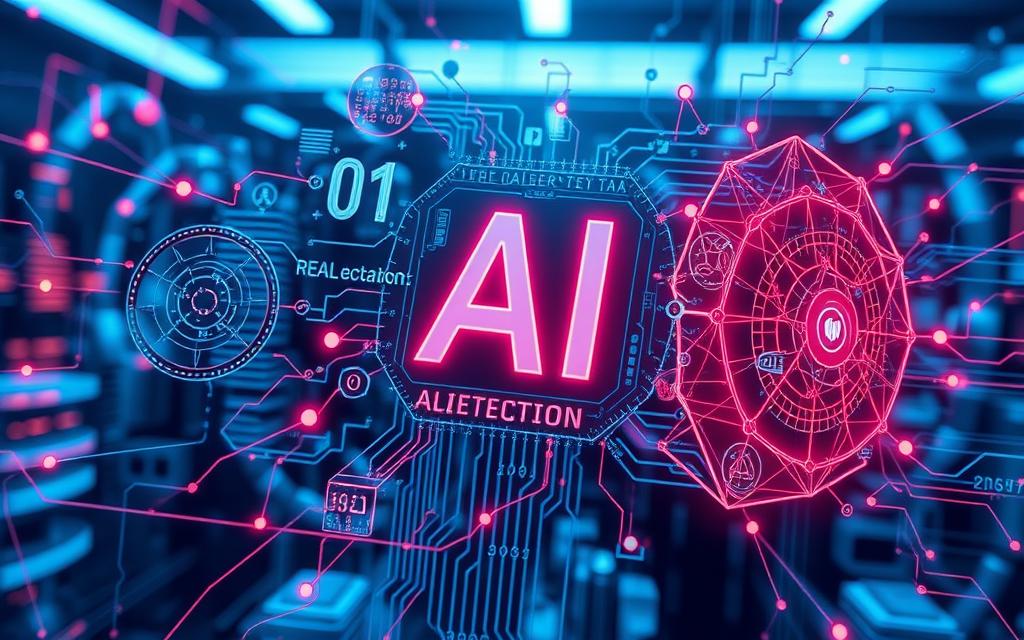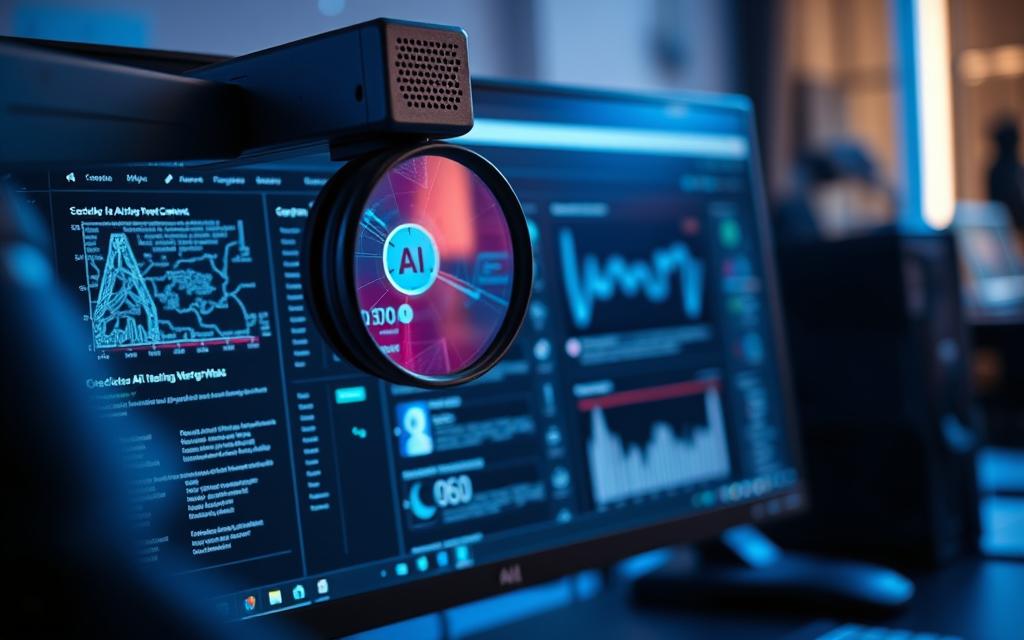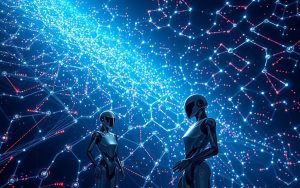Table of Contents
The internet has become a vast repository of information, but distinguishing between human-written and AI-generated content is becoming increasingly challenging. As sophisticated AI writing tools proliferate, identifying artificial content without specialized tools is growing more difficult.
The authenticity of content is crucial in various contexts, including academic settings, professional environments, and general online information consumption. Undetected AI-generated text poses significant risks, such as misinformation, academic dishonesty, and erosion of trust in online content.
This article will explore various free AI detector tools that can help verify the authenticity of online content. As AI detection technology continues to evolve, these tools are now accessible to anyone concerned about the credibility of the information they consume online.
The Rising Concern of AI-Generated Content
The rise of AI-generated content has raised significant concerns regarding authenticity and integrity. As AI language models become more sophisticated, they are increasingly being used to produce a vast array of written materials, from articles to essays.
This shift has significant implications across various industries, including journalism, marketing, and academia, where the authenticity of content is paramount. The ability to detect AI-generated content is becoming crucial for maintaining trust in digital content ecosystems.
How AI is Changing Online Content Creation
AI is revolutionizing online content creation by enabling the mass production of high-quality written materials at unprecedented scale and speed. AI writing models are being used to generate articles, essays, and other content types, challenging traditional notions of authorship and creativity.
Why Detecting AI-Generated Content Matters
Detecting ai-generated content is crucial for maintaining integrity in various fields. In academia, for instance, it ensures that students are not misusing AI tools for assignments. In journalism and marketing, it helps maintain the authenticity of published content.
| Industry | Impact of AI-Generated Content | Detection Importance |
|---|---|---|
| Academia | Potential misuse of AI tools for assignments | High |
| Journalism | Authenticity of published news articles | High |
| Marketing | Credibility of marketing content | High |
As AI continues to evolve, the need for effective AI detection tools will only grow, ensuring that the content we consume is trustworthy and authentic.
What Are AI Detector Free Tools?

Free AI detectors are software designed to identify content created by artificial intelligence systems. These detector tools analyze linguistic patterns, predictability, and other textual characteristics to determine if the content is AI-generated.
AI detection technology works by using sophisticated algorithms to compare submitted content against known patterns of AI-generated text. This process often employs machine learning techniques to improve detection accuracy over time.
How AI Detection Technology Works
The technology examines various aspects of writing, including sentence structure, word choice, repetition patterns, and contextual coherence, to identify potential AI authorship. By analyzing these elements, AI detectors can effectively detect ai-generated content.
Types of Content That Can Be Analyzed
Modern AI detectors can analyze a wide range of content types, including essays, articles, social media posts, emails, and even creative writing like poetry or fiction. Many of these tools are available for free online, making them accessible to various users.
Most free AI detectors work through simple web interfaces where users can paste text or upload documents for immediate analysis. While primarily designed for text analysis, some advanced detectors can also evaluate images and other media for signs of AI generation. For instance, you can try out the ZeroGPT tool to detect AI-generated content.
Top Free AI Detectors Available Today
In the era of AI-driven content creation, detecting AI-generated text has become essential. Several tools have emerged to address this need, offering varying levels of accuracy and features.
ZeroGPT: Advanced ChatGPT Detection
ZeroGPT is a leading free AI detector that utilizes DeepAnalyse™ Technology to identify content generated by ChatGPT and other advanced AI models. It highlights AI-written sentences and provides a percentage score of AI content.
Grammarly AI Detector: Beyond Grammar Checking
Grammarly’s AI detector goes beyond its grammar checking capabilities by assessing text against language patterns indicative of AI-generated content. It displays a percentage indicating the likelihood of AI generation.
Other Notable Free Detection Tools
Other notable free detector tools offer specialized features such as multi-language support and batch processing. While they may not match the accuracy of premium options, they provide valuable insights into AI-generated content.
How Accurate Are Free AI Detectors?
With the rise of AI-generated content, understanding the accuracy of free AI detectors is essential for evaluating online information. While AI detectors can help assess whether text appears to be AI-generated, currently, there is no AI detector that can conclusively or definitively determine whether AI was used to produce text.
Understanding Accuracy Limitations
The accuracy of AI detection tools can vary based on the algorithms used and the specific characteristics of the text being analyzed. Detection accuracy typically ranges from 70-90% depending on the tool, the type of content being analyzed, and how the AI-generated text was created or edited.
Factors Affecting Detection Reliability
Several factors can affect the reliability of detection results, including text length, complexity of content, subject matter, and whether the AI-generated content has been edited by humans. Different AI writing models produce text with varying characteristics, making some AI content easier to detect than others.
| Factor | Impact on Detection |
|---|---|
| Text Length | Longer texts are generally easier to analyze |
| Content Complexity | More complex content can be challenging to detect |
| Human Editing | Edited content can be harder to identify as AI-generated |
For more information on AI detection tools, you can visit Jeff Bullas’ AI Detector page. The “arms race” between AI content generation and detection technologies means that detection accuracy is a moving target. It’s essential to interpret results responsibly, understanding that they should be considered probabilistic rather than definitive proof of content origin.
Key Features to Look for in AI Detector Free Tools

When selecting an AI detector tool, several key features can significantly impact its effectiveness. The best AI detector tools offer a combination of features that enhance their utility and user experience.
Multi-Language Support
Multi-language support is a crucial feature, enabling users to analyze content in various languages beyond English. The AI Detector supports multiple languages, making it versatile for detecting AI-generated content in non-English texts, images, or media.
Detection Speed and Efficiency
The AI detection process is very fast, providing results in just a few seconds after uploading your text or image. This ensures that you can quickly determine if the content is AI-generated or not, which is particularly important for users who need to analyze large volumes of content.
Report Generation Capabilities
Comprehensive report generation capabilities are also essential, providing detailed breakdowns of detection results rather than simple binary judgments. This feature helps users understand the detection findings and take appropriate action.
DeepAnalyse™ Technology: How Modern AI Detection Works
DeepAnalyse™ Technology is at the forefront of AI detection, utilizing a comprehensive approach to identify AI-generated content. This pioneering technology employs a multi-stage methodology to analyze text at both macro and micro levels, ensuring a thorough examination of the content.
Multi-Stage Methodology Explained
The multi-stage methodology involves several components that work together to determine the origin of the text. By analyzing linguistic patterns, statistical anomalies, and other markers, DeepAnalyse™ Technology can effectively differentiate between human and AI-generated content.
Training Models on Diverse Text Collections
Our AI detection model is trained on extensive text collections from various sources, including the internet, educational datasets, and proprietary synthetic AI datasets produced using different language models. This diverse training enables the model to learn and improve its detection capabilities continuously.
The table below summarizes the key features of DeepAnalyse™ Technology:
| Feature | Description | Benefit |
|---|---|---|
| Multi-Stage Analysis | Examines text at both macro and micro levels | Enhanced accuracy in detecting AI-generated content |
| Diverse Training Data | Utilizes internet content, educational materials, and synthetic AI datasets | Improved ability to detect various AI-generated content types |
| Continuous Learning | Employs deep learning methodologies to refine detection capabilities | Staying up-to-date with evolving AI-generated content |
By leveraging DeepAnalyse™ Technology, users can rely on a robust detection system that is capable of identifying AI-generated content with high accuracy.
Common Use Cases for AI Detector Free Tools
Various sectors are leveraging AI detection tools to address their specific needs. AI detector free tools are being adopted in multiple fields, transforming how organizations approach content verification and authenticity.
Academic Integrity and Student Work
Educational institutions are increasingly using AI detectors to maintain academic integrity by identifying potentially AI-generated student papers, essays, and assignments. This helps educators adapt assessment strategies and encourage original student work.
Content Creation and Publishing
Content publishers, including news organizations and blogs, are implementing AI detection as part of their editorial workflows to ensure content authenticity. Marketing agencies also use detection tools to verify that freelancers deliver original human-written content.
Research and Fact Verification
Researchers and fact-checkers employ AI detection as part of their verification process when evaluating the credibility of sources and information. This helps ensure the accuracy and reliability of research findings.
| Industry | Use Case | Benefit |
|---|---|---|
| Education | Detecting AI-generated student work | Maintaining academic integrity |
| Publishing | Verifying content authenticity | Ensuring original content |
| Research | Evaluating source credibility | Improving research accuracy |
Potential Biases in AI Detection
The presence of biases in AI detection can compromise their ability to distinguish between human and AI-generated content. AI detectors are trained on vast datasets, which can sometimes reflect existing biases, particularly if the data is not carefully curated.
Language and Cultural Biases
AI detection systems can exhibit language and cultural biases, particularly when analyzing content written by non-native English speakers or those with distinctive writing styles. Detection models trained primarily on mainstream Western writing patterns may incorrectly flag authentic human content from different cultural contexts as AI-generated.
How Developers Address Bias Concerns
Developers are addressing bias concerns through diverse training datasets, comprehensive evaluation processes, and continuous refinement of their detection models. Analytical linguists and researchers play a crucial role in identifying and mitigating potential biases in detection technology. By leveraging user feedback and applying specialized research, developers can improve the fairness and accuracy of AI detection systems.
To minimize bias, it’s essential to develop AI models using quality datasets that undergo comprehensive evaluations for bias and fairness. This involves a collaborative approach, incorporating feedback from users and experts alike to ensure that AI detection systems are both effective and equitable.
AI Detection vs. Plagiarism Checking: Understanding the Difference
AI detection and plagiarism checking are two distinct technologies used to evaluate content originality, each serving a unique purpose. While both are crucial in maintaining content authenticity, they operate in different ways.
How Each Technology Works
Plagiarism checkers compare submitted text against vast databases of existing content to identify matching passages. In contrast, AI detectors analyze linguistic patterns and structural characteristics to determine if the content was generated by a machine. This fundamental difference in approach means that plagiarism detection focuses on identifying copied content, whereas AI detection determines the likely origin of original content.
When to Use Each Tool
Plagiarism checking is more appropriate when verifying citation practices or identifying unauthorized copying. On the other hand, AI detection is more relevant when verifying human authorship or maintaining content authenticity. Using both tools together provides a comprehensive content verification system.
| Feature | Plagiarism Checker | AI Detector |
|---|---|---|
| Purpose | Identify copied content | Determine if content is AI-generated |
| Methodology | Compares text against databases | Analyzes linguistic patterns and structure |
| Use Case | Verifying citations, detecting unauthorized copying | Verifying human authorship, maintaining content authenticity |
Integrating AI Detectors with Other Writing Tools
The integration of AI detectors with various writing and content verification tools is revolutionizing the content creation process. By combining AI detection with grammar checkers, style analyzers, and plagiarism detection, content creators can ensure a high level of quality and authenticity in their work.

Complementary Tools for Content Verification
AI detectors can be effectively paired with other tools to enhance content verification. Grammar checkers help refine the language, while style analyzers ensure consistency in tone and voice. Plagiarism detection tools verify the originality of the content, making it a comprehensive validation ecosystem.
Creating a Comprehensive Content Validation Workflow
To develop an efficient workflow, content creators can integrate AI detection at strategic points in the writing process. This involves using AI detectors alongside other verification tools to validate content quality without disrupting productivity. Educational institutions and publishing platforms are adopting such comprehensive validation systems to ensure academic integrity and content authenticity.
The Future of AI Detection Technology
The future of AI detection technology is poised to undergo significant transformations as it responds to increasingly sophisticated AI content generation models, creating an ongoing technological arms race.
As AI-generated content becomes more prevalent, detection technology must evolve to keep pace.
Emerging Trends in AI Content Detection
Emerging trends in detecting AI-generated content include more nuanced analysis of semantic coherence, reasoning patterns, and contextual understanding. Future detection systems may incorporate multimodal analysis, examining not just text but also associated images and formatting choices.
How AI Detectors Will Evolve
Machine learning approaches will continue to refine detection accuracy through exposure to diverse examples of both human and AI-generated content. The potential for blockchain and other verification technologies to complement traditional detection methods is also being explored.
| Trend | Description | Impact |
|---|---|---|
| Multimodal Analysis | Examines text, images, and formatting | Improved detection accuracy |
| Machine Learning | Refines detection through diverse examples | Enhanced reliability |
| Blockchain Verification | Creates immutable records of content provenance | Increased trust in content authenticity |
Conclusion: Making Informed Decisions About Online Content
As we navigate the complex digital world, distinguishing between human and machine-generated content becomes increasingly challenging. While free AI detector tools provide valuable assistance, they should be used as part of a broader critical thinking approach to evaluating online text authenticity. To maintain trust and integrity in digital content, it’s crucial to strike a balance between leveraging AI for content creation and transparency about how text is produced.
FAQ
What is the primary purpose of using a content detector tool?
The primary purpose of using a content detector tool is to verify the authenticity of online content by detecting whether it is generated by humans or language models.
How do I know if a text is AI-generated?
To determine if a text is AI-generated, you can use a detection tool that analyzes the content’s patterns and compares them to known AI-generated texts.
Are content detection tools reliable?
While content detection tools have made significant progress, their accuracy can vary depending on the complexity of the content and the models used.
Can plagiarism checker tools detect AI-generated content?
Plagiarism checker tools are designed to detect copied content, not specifically AI-generated content. However, some advanced tools may be able to identify AI-generated content as part of their analysis.
What are the key features to look for in a content detector tool?
When selecting a content detector tool, look for features such as multi-language support, detection speed, and report generation capabilities to ensure it meets your needs.
How can I use content detection tools for academic integrity?
Content detection tools can help educators and researchers verify the authenticity of student work and detect potential cases of AI-generated content, promoting academic integrity.
Are there any biases in AI detection technology?
Yes, AI detection technology can be susceptible to language and cultural biases. Developers are working to address these concerns by training models on diverse text collections.
How do AI detectors differ from plagiarism checking tools?
AI detectors are designed to identify AI-generated content, while plagiarism checking tools focus on detecting copied content. Both tools serve distinct purposes and can be used together to ensure content authenticity.









